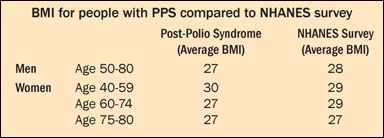Polio Place
A service of Post-Polio Health International
Aging Well with Post-Polio Syndrome: The Weight of the Matter
Category: Research
Rehabilitation Research and Training Center (RRTC) on Aging with a Physical Disability (2012)
Over the last 20 years, the rates of obesity in the United States have skyrocketed. More than one-third of U.S. adults (35.7%) are obese. Being overweight and obese is associated with a number of other preventable conditions, such as type II diabetes, coronary heart disease, stroke and several forms of cancer.
Obesity not only affects the health of older adults, it also affects their everyday lives. Older adults who are obese report more activity limitations and more feelings of sadness and hopelessness than those who are not obese.

The key to healthy aging is maintaining a healthy body weight throughout adulthood as well as later in life. As we age, our body gradually shifts. We lose muscle and gain fat. This shift slows our metabolism, making it easier to gain weight. In addition, some people become less physically active as they get older, increasing the risk of weight gain. For people aging with chronic conditions who have mobility limitations, maintaining a healthy weight can be even more challenging as finding types of physical activity and exercise that work for you and your body becomes more difficult.
There has been little research on the weight of people who were aging with a chronic condition. People with post-polio syndrome (PPS) who participated in our survey may recall answering a question about weight, height and waist circumference. The RRTC studied this data and recently published findings in the Disability and Health Journal.
Based on the answers received, we calculated Body Mass Index (BMI), which is weight divided by height, that results in a number commonly used to categorize if a person is underweight, normal, overweight or obese. In our research, we compared the data we collected to a larger sample of the general population from National Health and Nutrition Examination Survey (NHANES) that assesses the health and nutritional status of U.S. adults and children. We also looked at BMI by chronic condition (multiple sclerosis, post-polio syndrome, muscular dystrophy and spinal cord injury), age group and gender.
Our findings:
-
The average BMI for both men and women with PPS across all age groups was greater than 25, which is the standard for overweight.
-
In comparison to people with multiple sclerosis, spinal cord injury and muscular dystrophy, people with PPS, on average, had a higher BMI.
-
In comparison to the NHANES Survey group, on average, people with PPS had lower BMI, except for women in the youngest age group (40-59 years of age). In other words, people aging with PPS are in better shape compared to the general population aging in the United States. BMI was positively associated with age, years since diagnosis, mobility and interactions of some of these factors. For example, you are more likely to have a higher BMI if you are older, you've lived with your condition longer, and you have more severe mobility limitations.
-
No differences were found for waist circumference, which is unusual. There is much debate over the best ways to collect information on weight, height and waist circumference. Ideally, actually weighing someone on a scale and measuring height and waist circumference in-person is best rather than asking someone to report this on a survey, as we did.
-
To calculate your BMI, go to www.cdc.gov/healthyweight/ assessing/bmi/.
References and Resources:
Alschuler KN, Gibbons LE, Rosenberg DE, Ehde DM, Verrall AM, Bamer AM, Jensen MP. Body mass index and waist circumference in persons aging with muscular dystrophy, multiple sclerosis, post-polio syndrome, and spinal cord injury. Disabil Health J. 2012 Jul;5(3):177-84.
www.cdc.gov/healthyweight/assessing/bmi www.cdc.gov/healthyweight/calories
www.cdc.gov/healthyweight/losing_weight/ eating_habits.html
www.post-polio.org/edu/pphnews/ pph19-2a.html" target="_blank">www.post-polio.org/edu/pphnews/ PPH27-4fall11p10.pdf www.post-polio.org/edu/pphnews/ pph19-2a.html.
Tagged as: aging , health , nutrition , weight